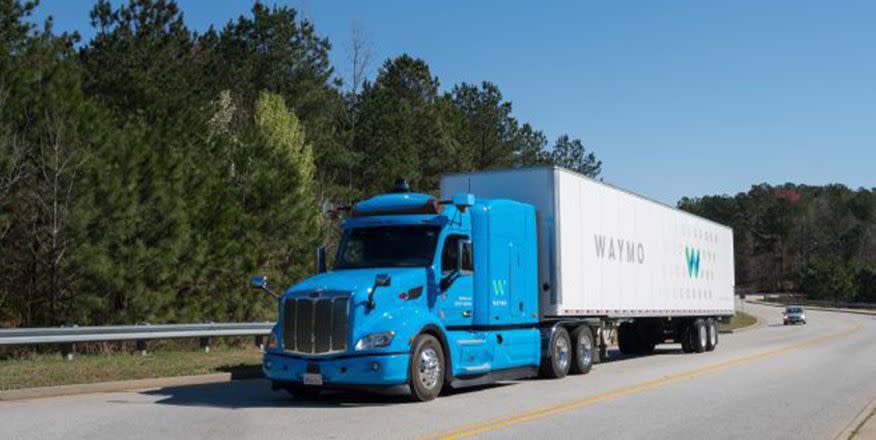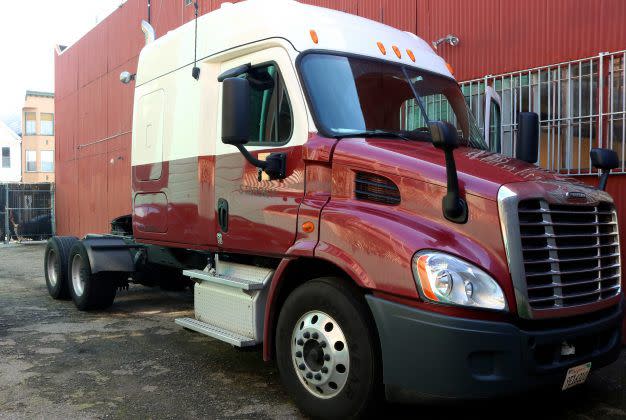Fear Not, Truckers: Robot Replacements Are Decades Away

The truck drivers who stand to lose their jobs to automated-driving technology? Many of them haven’t been born yet.
For all of today’s fretting over the potential for massive unemployment associated with the deployment of self-driving vehicles, a report issued last week by a transportation-policy think tank says the first ripples from automation won’t reach the labor market until the mid-2030s. Widespread impact won’t occur for more than a quarter of a century.
Even then, the report, published by Securing America’s Future Energy (SAFE), suggests job impacts will be minimal rather than a catalyst for broad economic turmoil. The SAFE think tank is a a nonpartisan advocacy group that argues for policies that will diminish reliance on foreign oil to bolster national security. Its report, entitled America’s Workforce and the Self-Driving Future, finds that automated vehicles could deliver trillions of dollars in economic and societal gains by reducing traffic crashes and increasing productivity.
In short, the report’s authors say, there’s plenty of time to plan for far-off disruptions, while the benefits of widespread automated vehicles will be substantial.
“It is hard to foresee any technological or other change on the horizon that can contribute more to economic growth and productivity,” the SAFE report’s authors write. “We believe that society does not have to choose between the compelling benefits of AVs and the stable evolution of the workforce.”

Roughly 1.8 million Americans drive heavy trucks or tractor-trailers for employment, according to the Bureau of Labor Statistics. Currently, there’s no problem with out-of-work truckers. In fact, the American Trucking Associations organization estimates, there’s a shortage of approximately 50,000 truck drivers.
After starting in the 2030s, autonomous-vehicle impact on the national unemployment rate won’t peak until the late 2040s, according to the report’s projections, when the arrival of autonomous vehicles will ultimately account for a 0.06 to 0.13 percent uptick in the unemployment rate. By comparison, the country’s marginal unemployment rate increased 4.9 percent during the Great Recession. Lifetime wages lost to unemployment each year would peak at about $18 billion at this time, per the report.
The prospect of job losses caused by automated vehicles has been a concern in Congress, where the proposed AV START Act, a bill that would smooth the regulatory path forward for automated vehicles, has languished. Michigan Democratic senator Gary Peters, a co-sponsor of the legislation, addressed the SAFE report at an event in Washington, D.C., last week.
“I’m not a job-apocalypse guy who thinks all the jobs are going to disappear,” he said. But he sees the rollout of autonomous vehicles as one small subset of a much bigger group of changes afoot in the U.S. economy.
“When automated vehicles can pilot through a city like Washington, D.C., using artificial intelligence, that means AI is ready for prime time in every single industry in America,” Peters said. “It will change everything in this country.”
If the SAFE projections are accurate, the economic benefits provided by automated vehicles far outweigh the costs. Automated vehicles could deliver $800 billion in annual gains during the same late-2040s time period by slashing traffic crashes, providing a bridge to far-flung employment opportunities for those with currently restricted mobility options, creating more productive time, and more. Those benefits, the report says, could have a cumulative value of $6.3 trillion between now and 2050.
As the SAFE report expresses it: “Economic and societal benefits offered by autonomous vehicles in a single year of widespread deployment dwarf the cost to workers incurred over multi-decadal deployment of automated vehicles when measured in purely economic terms.”
Those projections echo earlier ones in a similar report published in 2017 by the global consulting firm Strategy Analytics, which found that Level 5 autonomous vehicles could generate as much as $7 trillion in economic benefits by 2050.
A portion of the SAFE report examined those benefits through modeling how smaller midwestern and mid-Atlantic cities could benefit from reduced congestion and increased regional transit speeds. The authors estimate that a 10 percent increase in average speed would lead to a 15 to 18 percent increase in the size of respective labor markets because greater swaths of the population could reach a broader range of jobs.
For one example, the report’s models suggest that Gary, Indiana, currently has 388,802 jobs within commuting distance of its city center. With the reduced congestion promised by automated vehicles providing greater reach, 1,225,216 jobs could be considered within commuting distance, a 215 percent increase. In Elmira, New York, which had an unemployment rate of 7.6 percent in February 2018, the percentage increase of jobs within reach could rise 111 percent from 58,636 to 123,805.
Competition Heats Up in Race to Put Self-Driving Trucks on the Road
Autonomous Trucks Stoke Fears of Job Loss, But Others Say Drivers Won’t Be Displaced Soon
With so much of the current discussion devoted to how automated vehicles may upend transportation and personal-car ownership in big metropolitan areas where these cars are currently being tested, this portion of the SAFE report raises a novel aspect of autonomous vehicles that has largely been overlooked: Sure, self-driving vehicles may alter the transportation landscape in big cities, but there’s at least a possibility they also could offer benefits to the rest of the country.
You Might Also Like

 Yahoo Finance
Yahoo Finance 